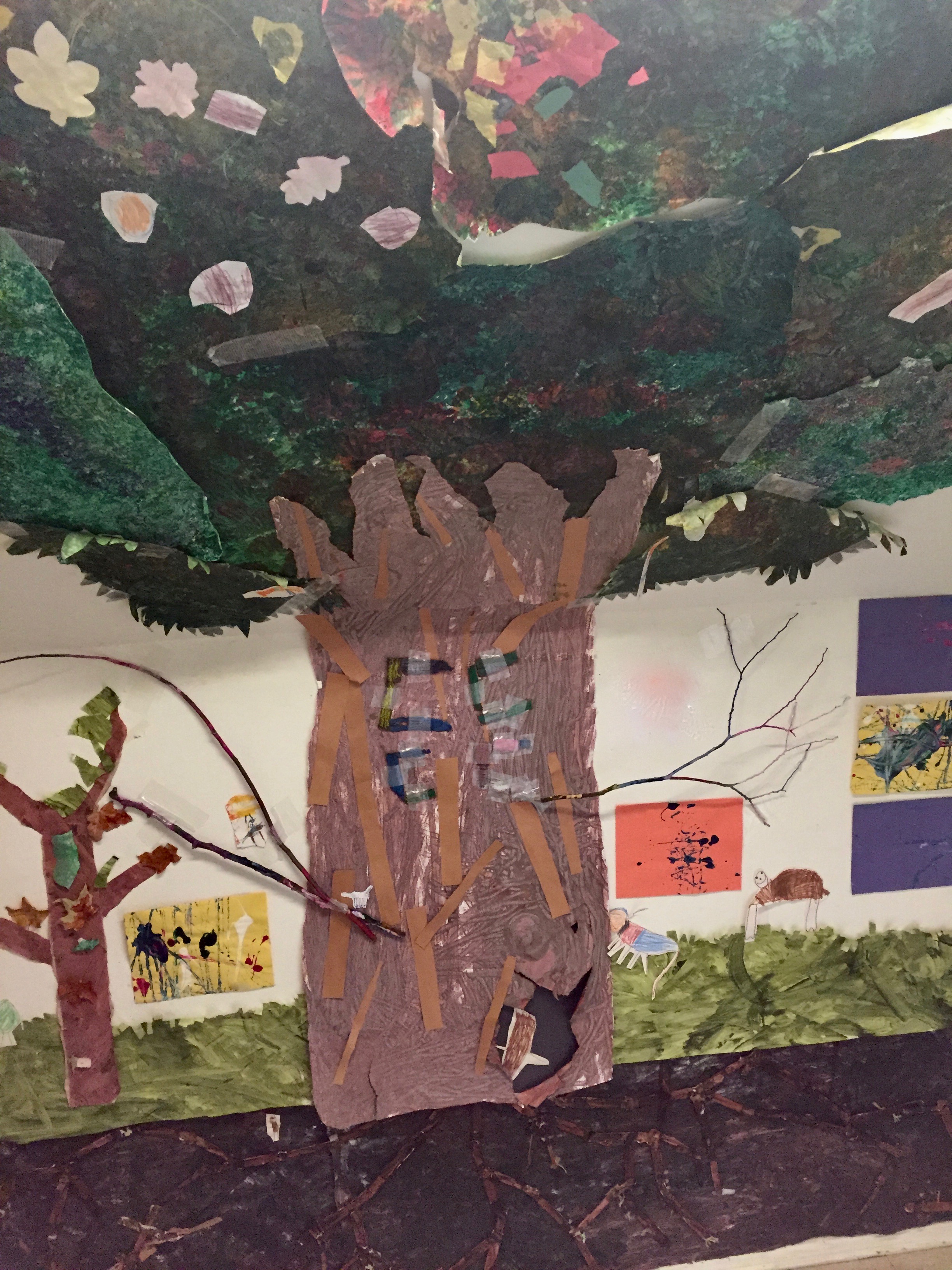Model-making and engineering in a preK program
By Peggy Ashbrook
Posted on 2017-12-28
Through visits to other programs, reading books, attending conferences and webinars, and having conversations with colleagues, I continue to learn about teaching young children. In conversation, preschool teacher Barbara Foster related how children used engineering design to make a model that represents their experience. She helps children deepen their understanding of natural phenomena through documentation of experiences and observations, making models, and reflecting on the documentation. The program uses emergent curriculum—they “believe that children learn best when engaged in work and play that is meaningful to them.”
Here’s Barbara:
A group of older children were working with their teacher on developing a model of a forest by posting paintings on the walls of the stairway landing. I approached my group of students to see what they wanted to add to the forest. The resulting project the class worked on involved using science and engineering practices (making a model, using tools), redesigning the process when it wasn’t working, and seeing how the part fit into the whole (core idea in science PS1.A Structure of matter. See page 108).
- Preschool children creating a model of a forest as they understand it.
- The model forest includes a model of a paper wasp nest, made of paper mâché.
We took a really long time to make a model of the paper wasp nest that had been removed from a tree in summer. First we made paper, beginning with tearing scrap paper up and soaking it for a very long time. But that didn’t work so we tried using hand beaters but that wasn’t sufficient so I found out how to do it—put the paper and water in the blender to make the paper pulp. With adult help the children used a screen frame to lift out a small amount of pulp to make a page of new paper. The pulp was smelly and a little too tactile for the children’s comfort so I took the it home to make a few more pages.
Once we had the paper we began making a piñata type structure using a balloon in the center and gluing on the pieces of paper. By the time it all dried, it stayed together and the pieces of paper that did not lie flat made it look like the real wasp nest. After removing the balloon we put a piece of the real nest that we had saved into the opening at the bottom of the structure. Looking at photos of real nest, the children and teacher compared it to their model of the nest and decided it needed to be painted to more closely match the real nest.
Then we added our model of the wasp nest to a tree in the model of the forest being established by another class in the stairwell landing. We also added water, clouds, and raindrops and a sun. The children have a real interest in the sun, perhaps inspired by one child whose family has a special interest in space. It’s interesting how different things come together—two children’s favorite color is yellow.
We’ve been taking photos of the sun from the same place and at the same time in the morning, about 10:15, a couple of times a month. The children aren’t really looking at the photos although they do want to take the photos. Sometimes they’ll say, “Come over here to take the photo,” moving closer to it at the edge of the play area, as though that will produce a better photo. I’ve been making sure to take the photos each month in case the children notice a change in position in it in the spring and want to compare it to the sun’s location in the sky earlier in the school year.
It takes a skillful teacher to see the significance of a child’s favorite color in science learning. Emergent curriculum means that instead of “doing” a theme or topic such as insects, weather, or sky, in a week of activities, teachers plan curriculum in response to children’s interests. Children’s ideas develop from their limited experiences. Teachers use their observations and the children’s work to plan additional experiences, help children revisit their earlier experiences, and build their understanding. With additional experiences and discussions, and as they mature, children replace early ideas that are not scientifically accurate with knowledge built from their experiences. Read about how models support children’s developing understandings in the Next Generation Science Standards APPENDIX F – Science and Engineering Practices in the NGSS.
There is much in common with Harlen’s work in Teaching Science for Understanding in Elementary and Middle Schools (Heinemann 2015) where she notes that children who are motivated by what they are doing and learning persevere and seek out new information. Consider using the “Action Points” at the end of the chapters for guidance when planning curriculum, even though Harlen is not writing for preschool educators. Two examples from Chapter 2, How Should We Teach Science?:
- When planning activities, consider the opportunities students have to make decisions rather than follow instructions.
- Remember that it is as important to know what does not work as what does work, so allow students to try their ideas and see for themselves what happens.
Reading about the directions emergent curriculum takes in other programs is another way to explore this philosophy:
Children Need Nature: An Emergent Curriculum Study by Kristina Eaddy, The Schuylkill Center blog. January 30, 2017.
http://www.schuylkillcenter.org/blog/an-emergent-curriculum-study/
The Command Center Project: Resolving My Tensions with Emergent Curriculum (Voices of Practioners column) by Luvy Vanegas-Grimaud.
Young Children. July 2017.
https://www.naeyc.org/resources/pubs/yc/jul2017/command-center-project
Dutton, A.S. 2012. Discovering My Role in an Emergent Curriculum Preschool.Voices of Practitioners. Young Children. 7(1): 3-17.
Disclaimer: The views expressed in this blog post are those of the author(s) and do not necessarily reflect the official position of the National Science Teaching Association (NSTA).







